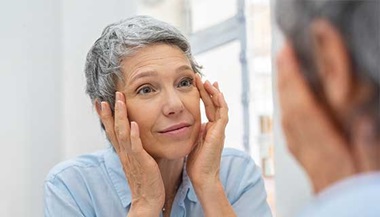Hidradenitis Suppurativa (HS)
Hidradenitis suppurativa (HS), sometimes called acne inversa, occurs when hair follicles near the underarms, groin, buttocks and under the breasts become infected and inflamed.
What You Need to Know
- When a hair follicle clogs, it can contain inflammatory material that creates a cyst. When the cyst bursts, the infection can spread to surrounding hair follicles, causing more cysts.
- In addition to lifestyle changes, treatment options include medication, hair removal, surgery, and laser treatments.
What is hidradenitis suppurativa?
Hair follicles that produce sweat on the underarms, groin, buttocks and under the breasts can become inflamed, and clog because they are unable to slough out dead skin cells. When this happens, the clogged follicle provides a breeding ground for bacteria. There is no way for the infectious material to escape the clogged hair follicle, so a cyst forms, similar to a large, thick pimple.
When the cyst bursts, the inflammatory material spreads to nearby hair follicles, and the process begins again. After a while, connections between the cysts develop, called sinus tracts, which join the follicles and making it even easier for inflammation and secondary bacterial infections to travel back and forth.
This painful condition can cause social isolation and depression. Many patients feel their quality of life is severely affected.
Who gets hidradenitis suppurativa?
HS affects 2% to 3% of the U.S. population, but the number may be higher because so few people discuss this painful condition with their doctors. HS effects four times more women than men. Other factors associated with developing HS include being:
- Black
- Obese
- A smoker
Hormonal influences are also thought to influence who will develop the condition, with most patients seeing a start at puberty and a second peak between ages 40 and 50.
Hidradenitis Suppurativa Q&A
Hidradenitis Suppurativa Symptoms
The primary symptoms of HS are the cysts themselves. The severity may vary, but, in general, people can experience:
- Severe itching
- Pain
- Scarring
- Sinus tracts, which are canals that join follicles
- Recurring infections
- Depression and withdrawal from social activities
Hidradenitis Suppurativa Diagnosis
Doctors diagnose HS by examining the cysts and follicles, and listening carefully to a patient’s history. There is no specific blood or laboratory test to diagnose HS.
Hidradenitis Suppurativa Treatment
While there is no cure, there are many treatments for HS, including oral medications, controlled opening of the cysts, and laser treatment. Your doctor will help determine which approach is appropriate for you. It’s possible you’ll use various treatments to decrease outbreaks.
Lifestyle Changes
Lifestyle changes can help reduce HS flare-ups. They include:
- Weight loss to lessen skin friction
- Wearing loose-fitting, breathable fabrics
- Anti-inflammatory diet
- Smoking cessation
- Limiting alcohol intake
Medication
A doctor may refer you to a dermatologist for HS treatment. Treatment often begins with oral medication such as antibiotics and anti-inflammatories, as well as topical medications including retinoids and steroids. Immunomodulating medications (which either stimulate or suppress the immune system) may also be used, depending on severity.
Hair Removal
Since HS is a disease of the hair follicles, laser hair removal can help reduce recurrence rates in some patients. Laser hair removal heats and damages hair follicles so that hair no longer grows. This helps reduce the inflammation that causes HS.
Patients typically see results in eight to 10 treatments.
Laser Treatments for Hidradenitis Suppurativa
Laser treatment is used an option for areas not treatable with surgery. Laser treatment, usually done with a CO2 laser, will help remove dead skin cells in the affected hair follicles and sweat glands and promote collagen growth. Lasers can also be used to treat the scaring associated with moderate to severe HS.
It typically takes three or more laser treatments to see results, and each session lasts 30 – 60 minutes. The treatment is not always covered by insurance.
After the laser treatment you may be prescribed pain medication and antibiotics. Your doctor will explain how to care for your wound and you may be required to return to the medical center to have your dressings changed.
Surgery
Surgery for HS is used to reduce outbreaks and severity of the condition. It is not a cure. For those with minor HS, it can reduce recurrence in troublesome areas.
Surgical approaches can include:
Deroofing: Tissue is carefully removed to reveal the tunnels beneath the skin.
Punch debridement: One inflamed bump is removed.
Surgical removal: When symptoms are persistent or severe, doctors may suggest removing all the affected skin. In some cases, a skin graft might be needed to help close the wound. However, it’s important to know that new bumps can pop up in other areas after surgery.
Surgery is most commonly used along with other medical treatments and lifestyle changes. After surgery, you will still need to continue using mediations prescribed by your dermatologist.







